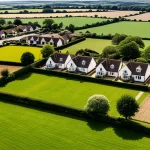Understanding Indoor-Outdoor Flow
Indoor-outdoor flow refers to the seamless transition between a building’s interior and exterior spaces. This concept plays a crucial role in UK properties, significantly enhancing the living experience by merging indoor comfort with outdoor beauty. Over time, UK architecture has evolved to incorporate these principles more meticulously, echoing trends seen in the warmer climates where such designs were initially more prevalent.
Originally, the concept was limited by the UK’s challenging weather conditions, yet rising demand for homes that maximize living space has led to innovative solutions. Historically, British homes featured smaller windows and separate rooms. However, the desire for seamless design has shifted preferences towards open spaces that blur boundaries, integrating various aspects like light and ventilation.
By fostering a seamless indoor-outdoor flow, homeowners can enjoy various benefits, including increased natural light, improved air circulation, and more expansive living areas. Such designs often create environments that encourage relaxation and social gathering, enhancing both aesthetic and functional qualities. As a result, UK homeowners increasingly favour properties with smartly designed transitions, prioritizing a seamless experience that bridges home interiors with the surrounding environment.
Design Strategies for Seamless Integration
Achieving a seamless design between indoor and outdoor spaces in UK properties involves carefully chosen strategies and techniques. Clever design tactics and thoughtful landscaping are essential to this integration.
Use of large windows and doors
Large windows and expansive doors are central to promoting an open atmosphere. They dissolve barriers, allowing natural light to flood indoor spaces while visually linking interiors and exteriors. Structures featuring sliding glass doors or advanced bi-fold systems are particularly effective, extending living areas outward.
Open floor plans
Open floor plans foster a unified space, enhancing the indoor-outdoor flow by minimizing walls that traditionally confine spaces. Such layouts encourage direct integration with outdoor areas, inviting nature into daily living environments.
Use of similar color palettes
Employing consistent color palettes indoors and out strengthens the visual connection. By selecting colours that complement nature, an uninterrupted flow is maintained, enhancing aesthetic harmony across spaces.
Material Considerations and Innovations
In the pursuit of a harmonious indoor-outdoor flow, selecting the right materials plays a pivotal role, particularly within the unique UK climate. Structures in this region must withstand variable conditions, from rain to cold temperatures, while maintaining aesthetic appeal. This balance is crucial for design innovation, allowing spaces to remain visually cohesive and functional year-round.
Materials such as treated timber, brick, and stone have traditionally been favoured for their durability. However, contemporary design innovation introduces alternatives like composite materials, which offer longevity and weather resistance without compromising style. These materials are versatile, available in various finishes that mimic natural substances, seamlessly complementing both indoor and outdoor elements.
Innovations in bi-fold doors and large sliding windows bring significant enhancements to UK properties, creating expansive openings that merge spaces effortlessly. Modern designs incorporate thermally efficient glass, offering insulation while maximizing natural light – a critical component in maintaining warmth and illumination, even during less favourable weather.
Composite decking is another notable advancement, popular for its low maintenance and versatility. It extends living areas outdoors, providing a seamless transition that’s both practical and stylish. These materials are not only resistant to moisture but are also eco-friendly, aligning with sustainable design aspirations.
In conclusion, the careful consideration of materials and integration of innovations in architectural features are key to achieving a cohesive and resilient indoor-outdoor flow in UK homes. Such choices not only enhance the visual and functional aspects of a property but also ensure durability and enjoyment throughout changing seasons.
Landscaping for Harmony
To create a harmonious indoor-outdoor flow in UK properties, landscaping plays a pivotal role. By carefully designing garden layouts, homeowners can ensure a seamless transition that complements both architectural and natural elements. The goal is to establish outdoor environments that not only extend living spaces but also enhance the home’s aesthetic harmony.
Creating Transitional Zones
Transitional zones act as bridge elements between indoor and outdoor spaces. These zones, often composed of patios or decks, serve as versatile areas that support various activities. By incorporating elements like pergolas or modestly elevated platforms, homeowners can foster a gradual transition from interior spaces to the garden, allowing seamless access and visual continuity.
Choosing Plants that Complement Architecture
Selecting the right plants is crucial for maintaining design continuity between indoor and outdoor settings. Opt for plants that resonate with the property’s architecture, considering both seasonal variations and spatial balance. In the UK, evergreens such as boxwoods or ferns provide year-round greenery, while flowering shrubs like hydrangeas add seasonal bursts of colour. Carefully chosen plants can soften structural lines and enhance the natural backdrop of a home.
Outdoor Furniture Placement and Design
Thoughtful placement of outdoor furniture is essential for encouraging interaction between spaces. Furniture should align with transitional zones, offering comfortable and inviting layouts. Incorporate pieces made from weather-resistant materials, ensuring durability through shifting UK climate conditions. Opt for sleek, minimal designs that reflect indoor aesthetics to keep the visual flow uninterrupted, favouring a seamless experience.
Landscaping not only enhances the visual appeal of UK properties but also supports functional integration between indoor and outdoor spaces. By combining clever plant selection, transitional zones, and strategic furniture placement, homeowners can achieve a unified design that embraces and elevates their entire living environment.
Addressing Challenges in UK Properties
Creating a seamless indoor-outdoor flow in traditional UK homes often presents unique challenges due to architectural and climatic constraints. Many older properties possess limited opportunities for integration due to their structural designs with smaller windows and compartmentalized interiors. These features can hinder openness and connectivity, making modern transformations more complex.
Weather in the UK acts as another significant obstacle, as homeowners must consider solutions that allow outdoor spaces to remain functional and inviting throughout varying conditions. To combat this, adaptable features like retractable awnings or covered patios can offer protection against rain and colder temperatures, ensuring year-round usability without sacrificing design continuity.
Furthermore, maintaining privacy while keeping spaces open can be a delicate balance. Innovative solutions such as strategic placement of fences, hedges, or privacy screens can help shield from external views and noise without blocking light or disrupting the visual flow. These solutions are instrumental in addressing the pragmatic aspects of connecting indoor and outdoor areas effectively.
By considering these factors, UK homeowners can overcome historical and environmental design obstacles, crafting living spaces that appreciate modern desires for seamlessness and integration. As more solutions become available, achieving a cohesive design that respects both privacy and weather conditions is increasingly attainable.
Trends and Future Directions
Understanding the current trends and future directions in outdoor living offers insights into how UK properties are evolving. As homeowners increasingly seek seamless indoor-outdoor flow, novel approaches are shaping this architectural journey. The shift towards sustainable design is at the forefront. Emphasizing eco-friendly materials and energy-efficient solutions is now a priority, reflecting a growing desire for environmentally responsible living spaces. These choices not only benefit individual homes but also contribute positively to broader ecological landscapes.
Technological innovations are playing a pivotal role. With advancements such as smart glass and automated systems, managing indoor and outdoor climates becomes simpler. These technologies enable efficient energy use and improved comfort, reinforcing the bond between indoor and outdoor environments. Additionally, they offer personalized control, allowing homeowners to tailor their living spaces to specific needs and preferences.
Popular themes emphasize natural materials and organic aesthetics, with a focus on bringing the outside in. This includes biophilic design elements that integrate nature within the home, fostering well-being and connectivity. As these trends gain momentum, the anticipation is that future design will continue to prioritize elements that support harmony between structures and the natural world.
Moreover, the social dimension of outdoor living spaces is evolving. There’s a growing trend towards creating communal environments that encourage interaction and leisure. This reflects a broader societal shift towards valuing community and shared experiences, making these designs both personal and community-centric.
Predicting the future of indoor-outdoor integration involves envisioning innovative, adaptable spaces that accommodate lifestyle changes while respecting environmental resources. By embracing these developments, UK homeowners can look forward to living spaces that offer the best of both worlds, blending indoor comfort with the refreshing appeal of the outdoors.




